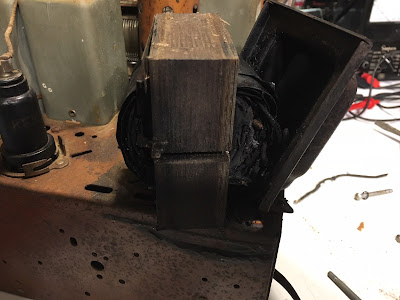Holy cow! It's already close to a month since I've posted anything! Where does the time go?
Truth is, I've gotten side-tracked by a couple other projects while waiting on some parts for the SDR-2017 project.
The first is an old Zenith 9-S-262 "Shutter Dial" that I electronically serviced for a friend. Wow, what a great old radio! The thing sounds fantastic and, in spite of needing multiple repairs, has been super easy to work on.
When I picked-up the set, I had a bad feeling about the power transformer, which ended up being justified because it was toast. Not just toast, but toast burnt crispy black. Bummer.
Fortunately, my habit of hanging on to crusty old radio carcasses came in handy and I had a suitable replacement. Cool!
After swapping the transformer, the rest of the repairs were routine: Replacing first the electrolytic filter caps and then the old wax-paper coupling and bypass capacitors.
Once this was done and new drive belts installed, I was able to give the set a "shake-down" test to evaluate any other problems that might be lurking. I was happily surprised to find that, other than dirty/noisy controls, the only other problems were a dead "eye" tube and sluggish "Robot Dial" motor.
Rebuilding the motor was trivial: Take it apart, clean out 80 years worth of crud, lubricate the bearing surfaces and reassemble. About half an hour's work had it working like new.
They eye tube required a little creativity. Zenith originally used a 6T5, a tube that is very scarce, with good examples selling for hundreds of dollars. That tube was long-gone from this set, having been replaced with the fairly common 6U5. Electrically, the tubes are interchangeable, but the eye pattern is different. I swapped the 6U5 for one that I had in my junk collection, but, alas, this tube was also very weak. So, off to Ebay.
6E5 tubes are reasonably plentiful and affordable, and are pin compatible with the 6U5, but have different gain characteristics; they're a bit "hotter", which means that the eye will be partially closed during no-signal conditions, and will close beyond 100% on strong signals. But, that's an easy fix: knock down the AVC voltage to the grid with a simple resistor divider and it'll work just fine. In this case, I used 100K in series with the AVC line and 1MEG to ground. Perfecto. Finis.
With that project out of the way but still waiting on parts to get back to work on the SDR-2017, I jumped into another "spontaneous construction" project: This one being an AM/FM broadcast receiver using a $0.23 TA2003 IC. Unlike many IC based radios, this one actually works well - more to come.
Truth is, I've gotten side-tracked by a couple other projects while waiting on some parts for the SDR-2017 project.
The first is an old Zenith 9-S-262 "Shutter Dial" that I electronically serviced for a friend. Wow, what a great old radio! The thing sounds fantastic and, in spite of needing multiple repairs, has been super easy to work on.
When I picked-up the set, I had a bad feeling about the power transformer, which ended up being justified because it was toast. Not just toast, but toast burnt crispy black. Bummer.
Fortunately, my habit of hanging on to crusty old radio carcasses came in handy and I had a suitable replacement. Cool!
After swapping the transformer, the rest of the repairs were routine: Replacing first the electrolytic filter caps and then the old wax-paper coupling and bypass capacitors.
Once this was done and new drive belts installed, I was able to give the set a "shake-down" test to evaluate any other problems that might be lurking. I was happily surprised to find that, other than dirty/noisy controls, the only other problems were a dead "eye" tube and sluggish "Robot Dial" motor.
Rebuilding the motor was trivial: Take it apart, clean out 80 years worth of crud, lubricate the bearing surfaces and reassemble. About half an hour's work had it working like new.
They eye tube required a little creativity. Zenith originally used a 6T5, a tube that is very scarce, with good examples selling for hundreds of dollars. That tube was long-gone from this set, having been replaced with the fairly common 6U5. Electrically, the tubes are interchangeable, but the eye pattern is different. I swapped the 6U5 for one that I had in my junk collection, but, alas, this tube was also very weak. So, off to Ebay.
6E5 tubes are reasonably plentiful and affordable, and are pin compatible with the 6U5, but have different gain characteristics; they're a bit "hotter", which means that the eye will be partially closed during no-signal conditions, and will close beyond 100% on strong signals. But, that's an easy fix: knock down the AVC voltage to the grid with a simple resistor divider and it'll work just fine. In this case, I used 100K in series with the AVC line and 1MEG to ground. Perfecto. Finis.
With that project out of the way but still waiting on parts to get back to work on the SDR-2017, I jumped into another "spontaneous construction" project: This one being an AM/FM broadcast receiver using a $0.23 TA2003 IC. Unlike many IC based radios, this one actually works well - more to come.

I find myself wanting a Magic Eye and a Robot Motor Dial. Great stuff Steve. Thanks and 73
ReplyDeleteMe too! I think an eye-tube might have to make an appearance in a future HB rig. Watching it flutter on weak, fading signals is nothing less than mesmerizing.
Delete